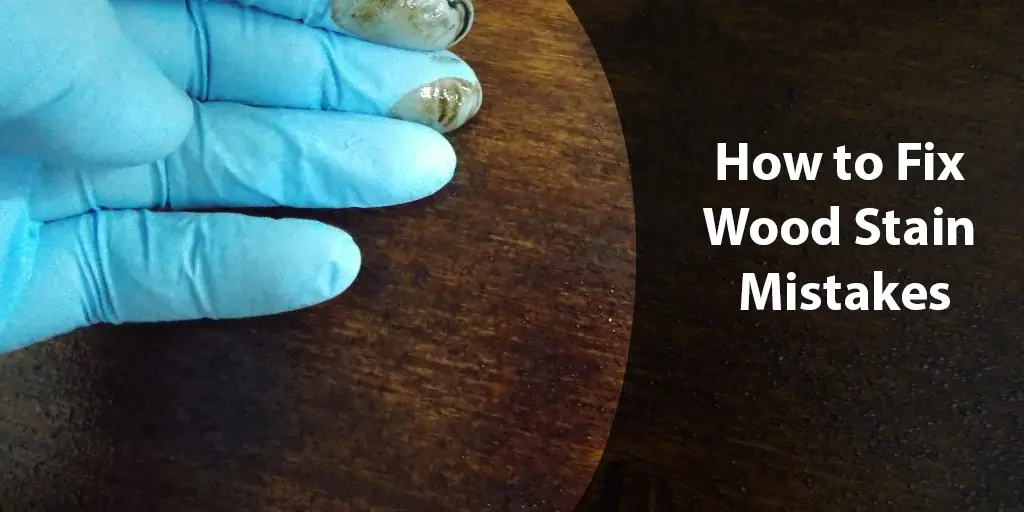Greetings, visitors! Welcome to this comprehensive guide on how to fix wood stain mistakes. If you’ve ever found yourself frustrated with uneven colors or blotchy spots on your beautiful wooden surfaces, fret not!

In this article, we will dive into the common mistakes made when applying wood stain and provide you with effective solutions to rectify them.
The Importance of Proper Wood Staining
Before we delve into the strategies to fix wood stain mishaps, let’s understand why proper staining is essential.
Wood stain not only enhances the aesthetic appeal of your furniture or flooring but also offers protection from scratches, moisture, and fading.
However, even with the best intentions, mistakes can occur during the staining process. Let’s explore some common errors and their respective fixes:
1. 🎨 Choosing the Wrong Stain Color
One of the most common mistakes is selecting the wrong stain color for your project. This can result in an undesirable outcome, leaving you dissatisfied with the final appearance of your wood.
To avoid this, it is crucial to test the stain on a small, inconspicuous area before proceeding with the entire project. This way, you can ensure that the color complements your existing decor and meets your expectations.
2. 🧽 Uneven Stain Application
Uneven stain application can create visible marks and patches on the wood’s surface. To achieve an even finish, start by thoroughly sanding the wood and removing any existing stain or finish.
Then, apply the stain using long, smooth strokes in the direction of the wood grain. Make sure to follow the manufacturer’s instructions for drying time and reapplication, if necessary.
3. 🌊 Blotchy or Dark Spots
Blotchy or dark spots can occur if the wood is not properly prepared before staining or if the stain is applied unevenly.
To address this issue, start by sanding the wood evenly and using a wood conditioner. The wood conditioner helps to seal the wood’s pores, ensuring an even absorption of the stain. Additionally, take care to apply the stain evenly and avoid over-saturation in specific areas.
4. 🧽 Inconsistent Color Intensity
If you notice inconsistent color intensity on your wood after staining, it may be due to the wood’s natural variations or inadequate coverage.
To ensure a consistent color, apply multiple thin coats of stain instead of one thick coat. Allow each layer to dry completely before adding another, ensuring that you cover the entire surface evenly.
5. 🎯 Stain Drying Too Quickly
Stains that dry too quickly can result in lap marks or visible brush strokes. To prevent this, work in smaller sections and apply the stain swiftly, swiftly spreading it onto the wood’s surface.
If necessary, use a stain applicator with a sponge or rag to facilitate smoother application and blending.
6. 😰 Staining Over Dirty or Rough Wood
A common mistake is staining over dirty or rough wood. Ensure that the surface is clean and free from dust, grime, and any previous finishes.
Sand the wood to remove roughness and create a smooth surface that will allow the stain to penetrate evenly.
7. 🤔 Lack of Protective Finish
Failing to apply a protective finish can leave your stained wood vulnerable to damage.
Once the stain has dried, apply a clear topcoat or varnish to protect the wood and enhance its longevity. This step also adds depth and enhances the richness of the stain color.
Strengths and Weaknesses of How to Fix Wood Stain Mistakes
Just like any technique, fixing wood stain mistakes has its strengths and weaknesses. Let’s take a closer look at both:
Strengths:
- Enables you to correct staining errors without completely starting over.
- Saves time and effort compared to redoing the entire staining process.
- Allows you to salvage wood surfaces that would otherwise appear unsightly.
- Enhances your understanding of the wood staining process and improves future projects.
- Provides an opportunity to experiment and customize the appearance of your wood.
- Cost-effective compared to professional refinishing services.
- Empowers you to take control of your DIY projects and achieve desired results.
Weaknesses:
- May require additional time and effort to rectify the mistake.
- Results may vary depending on the severity of the error and the type of wood.
- Not all mistakes can be completely fixed; some may leave a slight trace or require professional assistance.
- Vulnerable to human error and the possibility of further mistakes during the correction process.
- Requires proper understanding of wood staining techniques and materials.
- May involve the purchase of additional supplies or materials to rectify the error effectively.
- Time-sensitive; the quicker you address the mistake, the higher the chances of successful correction.
Table: Complete Information about How to Fix Wood Stain Mistakes
| Stain Mistake | Solution |
|---|---|
| Choosing the wrong stain color | Test the stain on a small area before proceeding with the project. |
| Uneven stain application | Sand the wood and apply the stain with smooth strokes in the direction of the grain. |
| Blotchy or dark spots | Sand the wood, use a wood conditioner, and apply the stain evenly. |
| Inconsistent color intensity | Apply multiple thin coats of stain, allowing each layer to dry before adding another. |
| Stain drying too quickly | Work in smaller sections and apply the stain swiftly, using a stain applicator if necessary. |
| Staining over dirty or rough wood | Clean the surface and sand the wood to create a smooth base for stain application. |
| Lack of protective finish | Apply a clear topcoat or varnish after the stain has dried to protect the wood. |
Frequently Asked Questions (FAQs)
1. Can I fix a wood stain mistake without sanding?
Yes, you can sometimes fix a wood stain mistake without sanding by using fine-grade steel wool or a chemical wood stain remover. However, sanding is often the most effective method to fix certain mistakes.
2. How long should I wait before applying another coat of stain?
The drying time between stain coats varies depending on the type of stain. Refer to the manufacturer’s instructions for the recommended drying time. It is important to ensure the previous coat is completely dry before applying additional layers.
3. What tools do I need to fix wood stain mistakes?
The tools needed to fix wood stain mistakes include sandpaper, wood conditioner, stain applicators (such as brushes or rags), fine-grade steel wool, and a clear topcoat or varnish for protection.
4. Can I use water-based stain over oil-based stain?
It is generally not recommended to use water-based stain over oil-based stain, as they may not bond properly. However, you can apply an oil-based stain over a dried water-based stain.
5. Is it possible to remove excess stain after it has dried?
While it may be challenging to remove excess stain after it has dried, you can try using a paint stripper or a fine-grade steel wool to lighten the color or fade the stain. It is advisable to test these methods on a small, inconspicuous area first.
6. How do I avoid lap marks when applying stain?
To avoid lap marks, work in smaller sections and apply the stain swiftly, blending the edges as you go. This ensures a continuous and even application without visible brush or roller marks.
7. Can I fix scratches or dents on stained wood?
Yes, you can fix scratches or dents on stained wood by using a wood filler or putty of a similar color. Apply the filler to the affected area, let it dry, sand it down, and then reapply stain and protective finish.
Conclusion
In conclusion, fixing wood stain mistakes is a valuable skill for any DIY enthusiast or homeowner. By avoiding common errors and employing the right techniques, you can transform flawed wooden surfaces into stunning pieces of furniture or flooring.
Remember to choose the appropriate stain color, prepare the wood properly, and ensure even application to achieve the desired results. Take action today and give your wood the attention it deserves!
Disclaimer: The information provided in this article is for educational purposes only and should not be considered professional advice. Always follow manufacturer instructions and consult with experts if needed.



